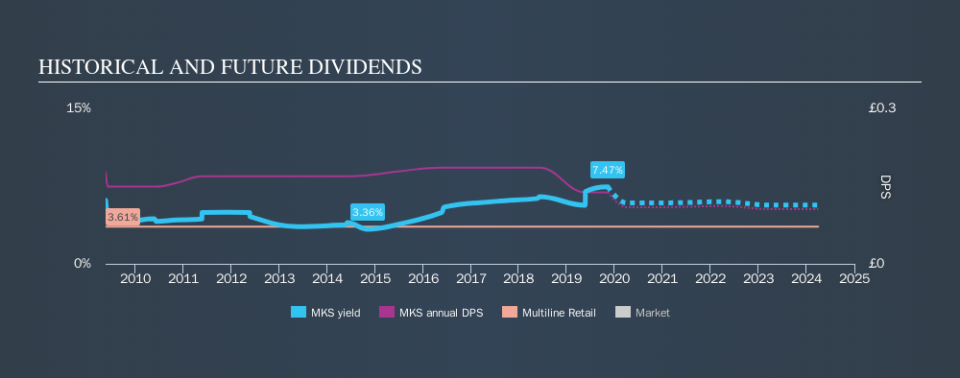It Might Be Better To Avoid Marks and Spencer Group plc's (LON:MKS) Upcoming 2.1% Dividend

It looks like Marks and Spencer Group plc (LON:MKS) is about to go ex-dividend in the next 3 days. This means that investors who purchase shares on or after the 14th of November will not receive the dividend, which will be paid on the 10th of January.
Marks and Spencer Group's next dividend payment will be UK£0.04 per share, and in the last 12 months, the company paid a total of UK£0.1 per share. Based on the last year's worth of payments, Marks and Spencer Group stock has a trailing yield of around 7.5% on the current share price of £1.86. Dividends are an important source of income to many shareholders, but the health of the business is crucial to maintaining those dividends. That's why we should always check whether the dividend payments appear sustainable, and if the company is growing.
See our latest analysis for Marks and Spencer Group
Dividends are typically paid from company earnings. If a company pays more in dividends than it earned in profit, then the dividend could be unsustainable. Marks and Spencer Group paid out a disturbingly high 218% of its profit as dividends last year, which makes us concerned there's something we don't fully understand in the business. Yet cash flows are even more important than profits for assessing a dividend, so we need to see if the company generated enough cash to pay its distribution. Dividends consumed 55% of the company's free cash flow last year, which is within a normal range for most dividend-paying organisations.
It's good to see that while Marks and Spencer Group's dividends were not covered by profits, at least they are affordable from a cash perspective. Still, if the company repeatedly paid a dividend greater than its profits, we'd be concerned. Very few companies are able to sustainably pay dividends larger than their reported earnings.
Click here to see the company's payout ratio, plus analyst estimates of its future dividends.
Have Earnings And Dividends Been Growing?
Companies with falling earnings are riskier for dividend shareholders. If business enters a downturn and the dividend is cut, the company could see its value fall precipitously. Marks and Spencer Group's earnings per share have plummeted approximately 31% a year over the previous five years.
Marks and Spencer Group also issued more than 5% of its market cap in new stock during the past year, which we feel is likely to hurt its dividend prospects in the long run. It's hard to grow dividends per share when a company keeps creating new shares.
Another key way to measure a company's dividend prospects is by measuring its historical rate of dividend growth. Marks and Spencer Group's dividend payments per share have declined at 2.4% per year on average over the past ten years, which is uninspiring. It's never nice to see earnings and dividends falling, but at least management has cut the dividend rather than potentially risk the company's health in an attempt to maintain it.
The Bottom Line
From a dividend perspective, should investors buy or avoid Marks and Spencer Group? Earnings per share have been in decline, which is not encouraging. Additionally, Marks and Spencer Group is paying out quite a high percentage of its earnings, and more than half its cash flow, so it's hard to evaluate whether the company is reinvesting enough in its business to improve its situation. Bottom line: Marks and Spencer Group has some unfortunate characteristics that we think could lead to sub-optimal outcomes for dividend investors.
Curious what other investors think of Marks and Spencer Group? See what analysts are forecasting, with this visualisation of its historical and future estimated earnings and cash flow.
If you're in the market for dividend stocks, we recommend checking our list of top dividend stocks with a greater than 2% yield and an upcoming dividend.
We aim to bring you long-term focused research analysis driven by fundamental data. Note that our analysis may not factor in the latest price-sensitive company announcements or qualitative material.
If you spot an error that warrants correction, please contact the editor at editorial-team@simplywallst.com. This article by Simply Wall St is general in nature. It does not constitute a recommendation to buy or sell any stock, and does not take account of your objectives, or your financial situation. Simply Wall St has no position in the stocks mentioned. Thank you for reading.

 Yahoo Finance
Yahoo Finance 
